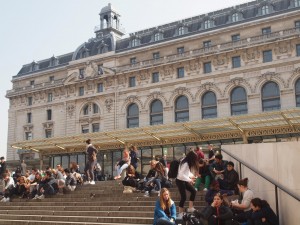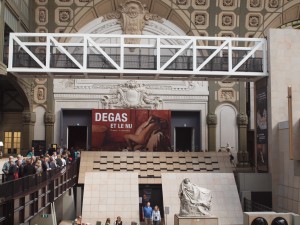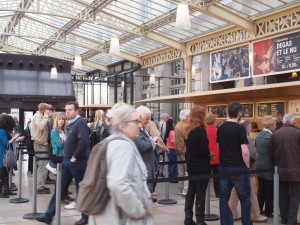
The main entrance to the Musee d’Orsay, the Impressionism Museum inserted within a former train station in Paris.
The Musée d’Orsay is by my estimation the most glorious adaptive use in the world. The conversion of a former train station – the Gare d’Orsay – into the museum for Parisian Art of the period between the Louvre and the Pompidou, which is primarily Impressionism – was completed in 1986 when I was in graduate school. The architect, an Italian woman, Gae Aulenti, came to Columbia to speak. I worked as a student assistant on our lecture series and met all the speakers (many, the starchitects of their time before that term existed) including Ms. Aulenti. As a young architect and historic preservation student, meeting an international woman architect who had just completed one of the grand projects of our era, I was star struck. I’ve always wanted to visit it, even though most of the photos I saw did not really do it justice. I’m happy to report that it did not disappoint.
The remaking of this monumental train station on the Left Bank overlooking the Seine and the Louvre, which was opened in 1900 to serve trains for the 1900 World Fair, created a cultural link between the Hotel de Invalides and Eiffel Tower and the Tuileries and the Louvre. As early as 1961 plans were announced to raze the station and build a hotel, that even Le Corbusier competed for. Fortunately, those plans went nowhere and in 1973 the building was put on the supplementary list of Historic Monuments and finally listed in 1978. One year later a group of three young architects was hired to renovate the building into a museum (ACT Architecture – Pierre Colboc, Renaud Bardon, Jean-Paul Phillippon.) Gae Aulenti was hired to plan the interior. The project floundered in financial uncertainty until Mitterrand was elected President in 1981 and immediately tripled its budget, allowing the project to proceed.
Light, Polychromy and Cast Iron
New walkways and walls were boldly and seamlessly inserted into the grand concourse of cast iron. Although built in 1900 originally when iron and steel were the material of choice, due to its location in the heart of historic Paris, it was determined that the exterior would need to be out of the more traditional stone and wrap around the modern, utilitarian iron structure. In the adaptation, original architect Victor Laloux’s cast iron columns and girders and stucco decoration were respected and restored, with the new structures leaving the historic readily apparent. Gae Aulenti designed a powerful new architecture for the interior, which could stand up to the immense volume of the concourse’s nave yet still harmonize with all the rooms. Basically, small stand-alone modern and clean structures were inserted into the nave, reading as separate “buildings” without damaging the openness of the grand space. Aulenti chose a pinkish flashed limestone for the new walls and green and yellow polychromy for the historic features – easily distinguishing the new from the old.
Sculpture occupies the ground floor of the concourse allowing the light to filter down from the domed skylights, while the paintings are located within the smaller rooms in the new structures. The grand clocks of the station remain as sculptures in their own right.

Gae Aulenti’s modern hand can be seen in the pinkish limestone of the new walls and the metal walkway. She used a polychromatic scheme of green and yellow to detail the historic decorative elements.
Paris – Where Two Churches Receive More visitors Than the Louvre or the Eiffel Tower
The Musée d’Orsay is the sixth most visited monument/museum in Paris where the most famous attractions include Notre-Dame de Paris, Basilique du Sacré-Cœur, the Louvre, the Eiffel Tower, the Pompidou Centre, Musée d’Orsay, Champs-Élysées, and the Arc de Triomphe.
With over 40 million tourists per year, Paris is the third most visited city in the world after Orlando and New York City, which is in some respects incredibly depressing. (Really, more people want to see DisneyWorld than the Empire State Building or Eiffel Tower?!) It is however, the first by international visitors (with about 17 million in city proper). The city and its region contain 3,800 historical monuments and four UNESCO World Heritage Sites.
Museums & Monuments are the Rock Stars of Attractions in Paris
Every place we went, the lines wrapped around the streets and this was off-season! It was encouraging to see so many people visiting museums, when American critics are often sounding the death knell for museums. I was nearly trampled by some elderly visitors, one in a wheelchair, trying to find the Cezanne exhibit at the Pompidou Center. We got the last table at the Musee Rodin café for lunch and almost feared for our lives from those who came after us!

The lines to get into the Musee d’Orsay at 10am on Saturday wrapped around the block. Fortunately we had museum passes that allowed us to bypass the lines.
Celebrating One Year
This week is the one year anniversary of my firm, BAC/Architecture + Planning, PLLC. In honor of that, I have written a blog a day for the five days of this week. I’m hoping that if I get into the habit of writing daily it might just stick! Thank you to all my readers, clients and colleagues for making this past year so wonderful and memorable.
And if you’d like to “subscribe” or follow this blog, True Green Cities, please sign up through the “Subscribe” button at the bottom left of this page. You’ll receive a daily recap when new blogs are posted.

